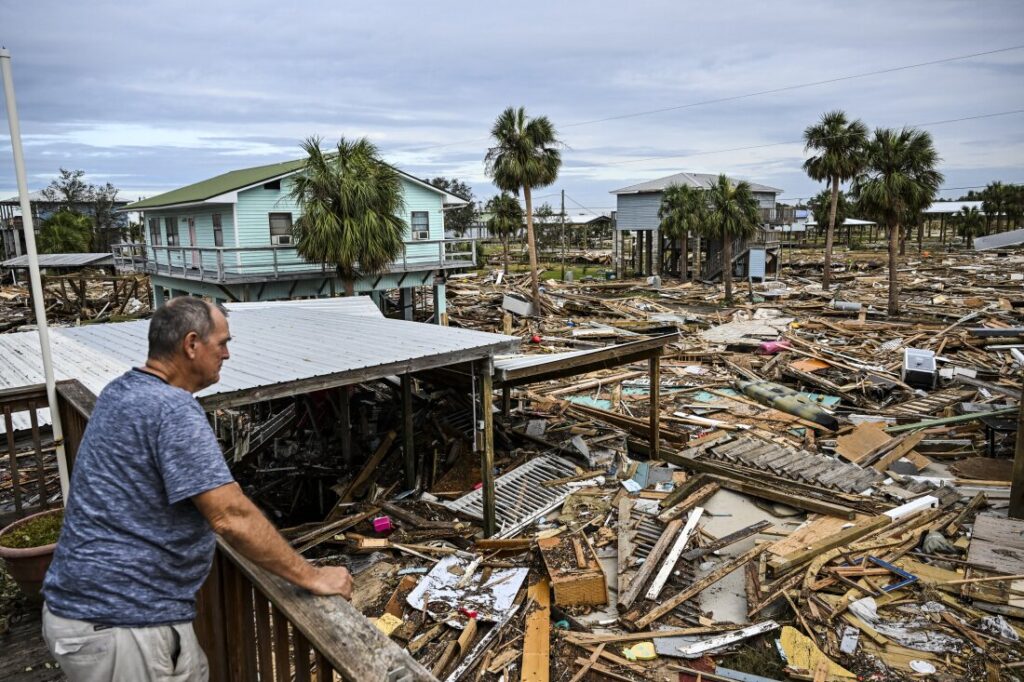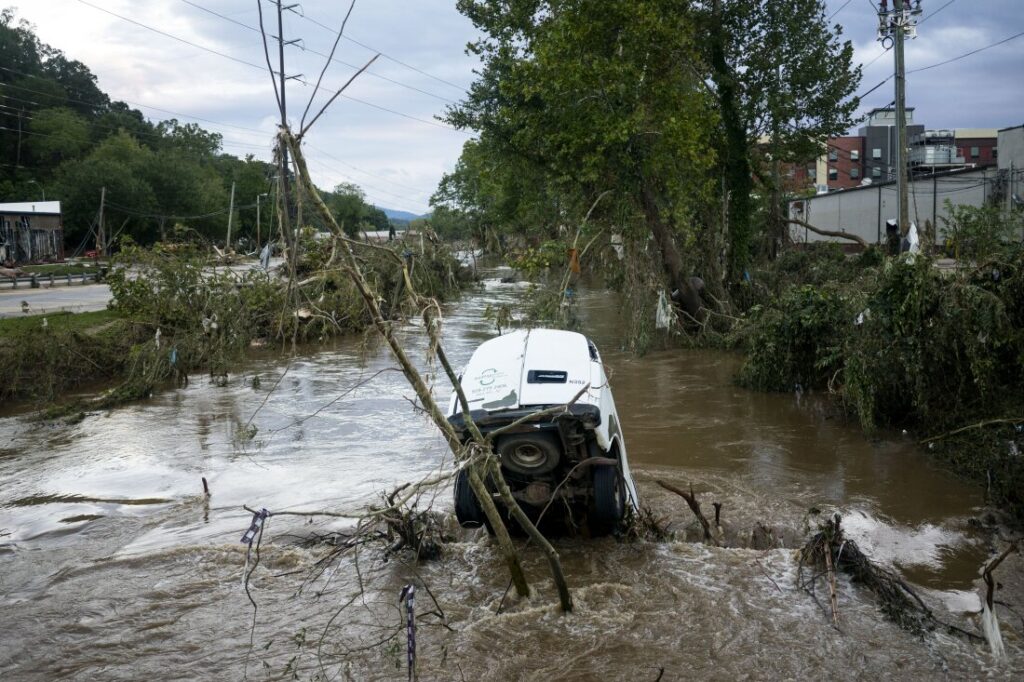Hurricane Helene made landfall with ferocious winds exceeding 140 mph, leaving a catastrophic path in its wake. By the time the storm reached Asheville, North Carolina, it had transitioned to a tropical storm, yet its impacts were nothing short of devastating. The city faced unprecedented rainfall, resulting in historic flooding that submerged entire neighborhoods and overwhelmed infrastructure. Major rivers like the French Broad and Swannanoa flooded their banks, inundating the city’s most cherished areas, including Biltmore Village and the River Arts District. The resulting destruction, both in terms of human life and property, is now being compared to some of the worst natural disasters the region has ever seen.
The aftermath in Asheville was particularly severe due to the city’s geography. Surrounded by mountains, heavy rainfall turned normally peaceful rivers into torrents, overflowing and causing flash floods. Biltmore Village, a popular tourist destination known for its charm, was particularly hard-hit. Streets were transformed into rivers, carrying debris and vehicles along with the fast-moving waters. The flooding not only caused significant property damage but also left parts of the city inaccessible for days. Thousands of residents were left without power, and many businesses were forced to close indefinitely as the extent of the damage became clear.
The Scale of Destruction:

The scale of destruction in Asheville following Hurricane Helene is staggering. Biltmore Village, with its historic architecture and bustling businesses, was one of the most affected areas. Streets that typically welcomed tourists and locals alike became waterways. The Swannanoa River, which runs through the village, surged over its banks, leaving cars partially submerged and sweeping away anything not anchored down. Residents who evacuated early returned to find their homes flooded, and businesses—many of which had weathered previous storms—were left with severe water damage, shattered windows, and ruined inventory.
Similarly, Asheville’s River Arts District, known for its vibrant artistic community, saw massive flooding. The French Broad River overflowed, turning streets into canals and flooding art studios, galleries, and local businesses. The cultural heart of the city now faces a long road to recovery, as water damage wreaked havoc on artwork, equipment, and buildings themselves. In both areas, the infrastructure crumbled under the weight of the storm. Bridges, roads, and essential services were rendered unusable. This flooding event, exacerbated by the city’s mountainous terrain, forced emergency services to prioritize rescues and evacuations, often navigating treacherous waters to save those trapped by the rising floodwaters.
In addition to these iconic areas, residential neighborhoods across the city experienced significant destruction. Homes were destroyed or severely damaged, with some completely swept off their foundations. Many buildings, unable to withstand the deluge, suffered from collapsed roofs and walls. For those lucky enough to escape with their lives, the loss of personal property and memories has been overwhelming. Power outages further complicated rescue and recovery efforts, with millions across the region left in the dark for days.
Human Impact
The human toll of Hurricane Helene continues to rise, with dozens of lives lost and many more injured. Asheville, typically a serene city nestled in the Blue Ridge Mountains, became a scene of devastation and trauma as the storm swept through. Emergency services were overwhelmed by the volume of calls for rescue as rising floodwaters trapped people in their homes and vehicles. Many were forced to flee to higher ground or designated shelters, with over 10,000 residents displaced across the region. The aftermath saw families separated, personal belongings lost, and entire neighborhoods turned into disaster zones.
First responders worked tirelessly, navigating floodwaters to rescue stranded individuals. Helicopters, boats, and high-water vehicles were dispatched to assist with evacuations, but access was limited due to impassable roads and collapsed bridges. Hospitals in the area faced a surge of injuries ranging from minor cuts and bruises to severe trauma caused by debris or collapse of structures. Temporary shelters were established, but the needs of the displaced stretched resources thin. Local charities, national organizations like the Red Cross, and community volunteers banded together to provide food, clothing, and medical assistance, yet the sheer number of affected residents posed significant challenges in offering immediate relief.
Community Resilience and Support

In the wake of Hurricane Helene, both federal and local relief efforts were swiftly mobilized. The Federal Emergency Management Agency (FEMA) issued a major disaster declaration, allowing access to critical funds for rebuilding. Local governments and community organizations banded together to coordinate shelter, medical care, and distribution of food and water. Volunteers from across the state poured in, assisting with cleanup and providing emotional support to the devastated communities. Amid the destruction, stories of resilience emerged. From neighbors helping each other evacuate to businesses offering their resources to aid recovery efforts, the spirit of Asheville’s community shone through the darkest days.
One particularly moving account came from a family trapped in their home in the River Arts District. As floodwaters rose, they were forced to the roof, awaiting rescue for hours before emergency responders could navigate the treacherous waters to save them. Despite the loss of their home, they expressed immense gratitude for the responders and volunteers who ensured their safety. Similarly, business owners in Biltmore Village came together to protect what little they could, forming human chains to carry supplies and salvage items before waters engulfed their shops. Such acts of solidarity have reinforced the community’s commitment to rebuild stronger.
Hurricane Helene: Post-Damage Safety Tips in Asheville North Carolina
- Wait for Clearance: Returning to your home prematurely can expose you to unsafe conditions. Authorities will assess the situation for structural damage, gas leaks, and electrical hazards. Always wait for official clearance before re-entering your home to avoid injury or further risk.
- Inspect for Structural Damage: Once it’s safe to enter, carefully inspect your home for signs of damage. Look for cracks in walls, ceilings, or foundations, and check for sagging floors. Structural damage can pose a significant risk of collapse, so contact professionals if you notice any concerning issues.
- Avoid Electrical Hazards: Water and electricity are a dangerous combination. Never touch electrical outlets, appliances, or systems if they’ve been exposed to water. It’s critical to hire a licensed electrician to inspect your home for wiring damage, especially if there was extensive flooding.
- Clean with Caution: Floodwaters often carry contaminants like sewage, chemicals, and debris. When cleaning, wear protective gear including gloves, boots, and masks. Avoid direct contact with floodwater to reduce exposure to harmful bacteria or hazardous materials. Ensure proper ventilation during the cleanup process.
- Sanitize Contaminated Areas: After removing debris, disinfect all surfaces to eliminate bacteria and mold. Items like carpets, furniture, and porous materials that have been soaked in floodwaters should be discarded, as they are breeding grounds for mold. Use bleach or other disinfectants on hard surfaces, and ensure affected areas are thoroughly dried to prevent long-term health hazards.
- Gas Leaks: If there is a smell of gas or a hissing sound, immediately leave the area and call the gas company or emergency service. Do not turn any lights or electrical devices on; a spark may cause an explosion.
- Water Safety: Do not drink tap water until local water authorities say it is safe. Flooding can affect the water supply and could be contaminated. Use safe bottled water, or boil water before consumption or using it for cooking or hygiene.
- Photo/Video Documentation of Damages for Insurance Claims: Avoid cleaning up or repairing anything until the damage has been thoroughly documented with photos and/or videos. This is necessary when filing insurance claims. Make a complete list of the damaged items and their approximate values.
- Mold Prevention and Remediation: Mold growth may begin within as little as 24-48 hours following the start of flooding. The key is to act quickly, drying out areas completely using fans, dehumidifiers, and open windows. If mold has spread uncontrollably, then it is best to seek the help of a professional mold remediation company, as mold may pose serious health risks to individuals, especially those with respiratory disorders.
- Waste Disposal: Waste disposal is also one of the challenges in disaster management. Separate hazardous waste from other debris: chemicals, paints, and batteries. Follow the local guidelines for the disposal of these materials so that environmental contamination does not occur.
- One could feel traumatized by a natural disaster; this may lead to stress, anxiety, and even PTSD. If the need arises, use community resources for mental health or a hotline. Also, encourage family-especially children-to talk about their feelings, and seek professional support if needed.
- Temporary Shelter and Basic Needs Supplies: Find temporary shelter if your home is not habitable through local disaster relief organizations like the American Red Cross or through FEMA. They can also provide you with access to such essential supplies, food, and healthcare services.
- Fire Safety: Be extremely careful with candles and generators. Fires are among the most common hazards following disasters because of lost electricity. Place candles in non-tip holders and away from flammable materials and have them monitored at all times. Generators should be operated outdoors in well-ventilated areas to prevent carbon monoxide poisoning.
- Stay Informed and Connected: Continue monitoring official advisories with local news, weather apps, and emergency alert systems. Have a fully charged phone and a backup of battery packs or solar chargers for use during extended power outages. Connect with neighbors to also share resources and ensure the community’s safety.
- Safety for Children and Pets: Keep children and pets away from unsafe, dirty places, and do not let them come in contact with hazardous debris, floodwaters, or chemicals. Look for any signs of distress or injury; take them to medical care if necessary. Keep pets leashed or crated to prevent them from wandering into dangerous zones.
- Be Prepared for Aftershocks or Secondary Hazards: Other hazards might include mudslides, landslides, flooding, or collapse of infrastructure. Monitor for potential aftershocks or continued hazards and follow any emergency instructions to know when you can safely return to your home or community.
- Financial Assistance: You can contact disaster recovery groups, such as FEMA and your state’s emergency management office, to find out if financial assistance is available toward home repairs, temporary housing, and personal losses. Most of the nonprofit organizations give grants or packages for the survivors of a disaster.
Conclusion
As Asheville begins the long process of rebuilding, the importance of community has never been clearer. The storm may have wreaked havoc on homes, businesses, and landscapes, but it has also ignited a collective determination to recover. With federal aid, local support, and a deeply rooted community spirit, the city is poised to emerge from this disaster more united than ever. Though the road ahead is challenging, Asheville’s history of resilience suggests that it will rise again, transforming adversity into an opportunity for renewal and growth. The rebuilding process may take time, but the strength of its people ensures a brighter future for the city.

